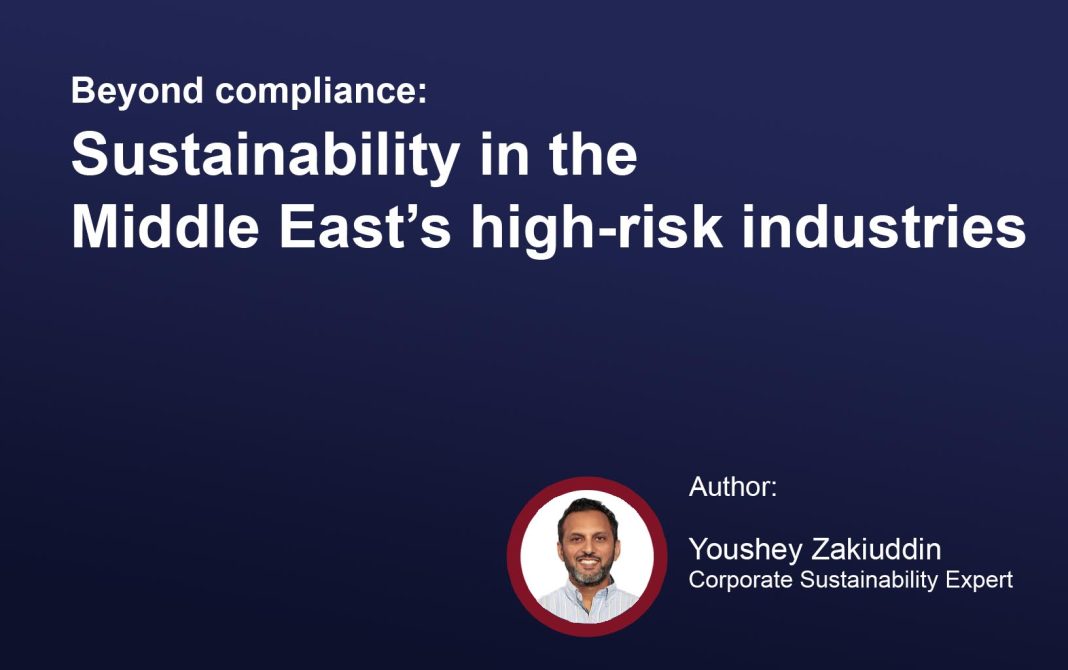In the blistering summer of 2023, when Gulf temperatures pushed past 50°C, construction crews across the region stopped work – not because of law, but because it was simply too dangerous to continue. It was a sobering reminder: the industries that power the Middle East’s economies are also the ones most exposed to climate and human risk.
In sectors like oil and gas, construction, and mining, the stakes are high. These industries aren’t just high-value – they’re high-risk. Environmental degradation, worker safety issues, and long-term viability hang in the balance. That’s where Environmental, Social, and Governance (ESG) practices come in – not as a compliance tick-box, but as a foundation for resilience, innovation, and trust.
Let’s take a closer look at how ESG is reshaping four of the region’s most high-impact sectors.
1. Oil & Gas:
Oil and gas remain the economic backbone of the Gulf, contributing over 40% of GDP in several GCC nations. But as the world shifts toward a low-carbon future, the industry finds itself under mounting pressure – to reduce emissions, improve transparency, and lead the region’s clean energy ambitions.
According to ESG Mena, companies like ADNOC and Saudi Aramco are stepping up. ADNOC has pledged to reach net-zero emissions by 2045, making it one of the first major players in the region to put such a target on paper. Its investment in carbon capture and storage – particularly through the Al Reyadah facility – is a signal of intent. Meanwhile, Aramco is expanding its climate disclosures and exploring alternative fuels like green hydrogen.
Still, progress is uneven. Methane leakage, flaring, and governance gaps continue to challenge the sector. As Sustainability Middle East notes, international ESG standards like those from the Global Reporting Initiative are providing a framework for more consistent, credible reporting.
The big picture? ESG isn’t a threat to oil and gas dominance – it’s the playbook for adapting to what comes next.
2. Construction & Real estate
From Saudi Arabia’s NEOM to Dubai’s post-Expo expansion, the Middle East is in the midst of a building boom. But these bold architectural visions face ESG hurdles that are as big as the projects themselves – extreme heat, scarce resources, and labour ethics in a migrant-heavy workforce.
Construction is one of the largest employers in the region, yet often among the most exposed to social risk. Worker wellbeing, heat stress, and fair labour practices can’t be treated as afterthoughts. Some UAE developers are starting to lead by example – introducing wearable sensors to monitor heat exposure and adjusting shift patterns to protect workers during peak hours.
On the environmental side, there’s growing momentum for LEED-certified buildings and green codes. In cities like Abu Dhabi and Doha, we’re seeing sustainable material sourcing, better waste management, and circular practices becoming part of the blueprint.
Ultimately, ESG in construction isn’t just about greener buildings – it’s about building with conscience.
3. Mining & Extractives
Saudi Arabia’s ambition to become a global mining leader has breathed new life into the region’s extractive industries. But mining comes with baggage – land disruption, heavy water use, and community displacement among them.
As ESG Mena reports, new projects are beginning to align with global best practices, including the IFC’s Performance Standards and the GRI’s sector-specific disclosures. These aren’t just box-ticking exercises – they’re tools to help companies identify and manage risk early.
Ma’aden, for instance, has ramped up its environmental impact assessments and community outreach. Local engagement is becoming less about obligation and more about partnership.
But let’s be clear: sustainability in mining isn’t an optional layer. It has to be built into the foundation – otherwise, the long-term costs may outweigh short-term gains.
4. Utilities & Waste
Few challenges define the Middle East more than water scarcity. Desalination plants are essential – but they’re energy-intensive and create brine that can damage marine ecosystems.
Dubai is working to change that narrative. Green desalination powered by solar energy and low-energy reverse osmosis technologies are already in development. Meanwhile, the city’s Waste-to-Energy plant – the world’s largest – is designed to convert nearly two million tonnes of waste into clean electricity each year, according to Sustainability Middle East.
It’s a clear signal: infrastructure players are beginning to see ESG not as overhead, but as opportunity. The utilities sector has the chance to transform from being a silent emitter to a sustainability innovator.
Conclusion: ESG is the next competitive advantage
In a region where high-risk sectors are cornerstones of economic growth, ESG offers a dual benefit – it protects and it propels. It protects companies from reputational, environmental, and operational shocks. And it propels them toward new opportunities, better governance, and stronger stakeholder trust.
As national visions like Saudi Vision 2030 and the UAE’s Net Zero 2050 gather momentum, the message is clear: the future belongs to companies that choose to lead the transition, not resist it. For high-risk industries, ESG isn’t just about doing less harm – it’s about creating more value.
About Author:
Youshey Zakiuddin is a Corporate Sustainability and Internal Communications professional at du, a leading telecommunications company in the UAE. With a strong background in sustainability reporting, environmental education, and corporate social responsibility (CSR), Youshey is dedicated to driving impactful initiatives that align with global sustainability goals. His expertise encompasses stakeholder engagement, ESG strategy, and the integration of sustainable practices within corporate frameworks.






